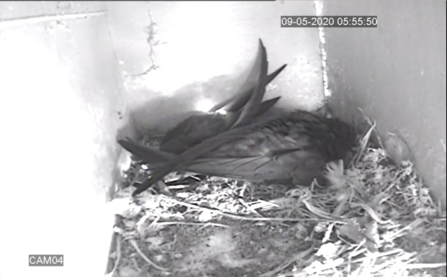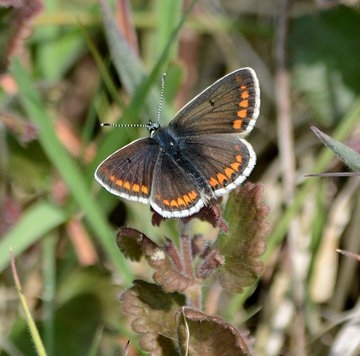Already spotted over the last week or so are damselflies. These delicate insects with gossamer wings are quite an easy catch for many a nesting bird and as they emerge in large numbers, starting with the large red damselfly, they provide a sustainable diet for the early nesters such as robins and whitethroats, as well as the later arrivals such as the hirundines - the swallows and martins. These swoop low over the lakes catching a whole variety of insects. Hobby are also being seen and they will prey on the larger insects such as dragonflies and the odd larger butterfly. Our swifts from last year have returned back to their nest box and are settling in well. Spotted flycatchers, too, have returned to Lackford Lakes and we hope they too will be nesting here.
Spring still continues...
Lackford Lakes by Mark Gosbee

Swifts nesting in the swift box at Lackford Lakes
Many of the blue damselflies are also out and the first dragonfly of the year, surprisingly, turns out to be an emperor dragonfly near the viewing platform. Usually, the broad-bodied chaser is one of the first dragonflies to be seen, but with things the way they are, sightings are a bit sporadic at the moment. Butterflies are also on the wing now, with brown argus, holly blue and small coppers being seen, especially in the warm weather we’re having of late. Bumblebees and mining bees are also busy around the reserve collecting pollen from a whole variety of flowers.

Brown argus - Rob Quadling
Like never before, insects need our help. Some of the birds mentioned above are in serious decline and they rely on insects to survive and breed. Spotted flycatcher numbers are down 93% since 1970 and the nightingale has also declined by 90% in the same period. This is a shocking decline in part due to habitat loss and the 41% decrease in insect populations. However, you can help - join our Action for Insects campaign and take #ActionForInsects here.

Spotted flycatcher - Amy Lewis
Remember, that during this time all of our reserves are open, but the visitor centre, toilets and hides will remain closed. But we have placed a sightings board outside the visitor centre for you to record your sightings.

